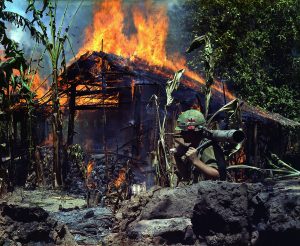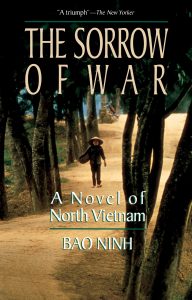Christie Cheng is currently enrolled in the Masters in Cultural Studies programme at SOAS and is particularly interested in understanding contemporary Southeast Asian cultural production through film and literature. Prior to her MA course, she read English Literature at the National University of Singapore and worked as an Arts Manager for the Literary Arts Department at National Arts Council, Singapore.
Constructing a History of Remains in Bảo Ninh’s The Sorrow of War

Bao Ninh The Sorrow of War – U.S. National Archives and Records Administration
Composed of scraps of diary entries belonging to a narrator who, “[d]espite his conviction, his dedication, […] sometimes suspects his recall of certain events”, Bảo Ninh’s The Sorrow of War appears to offer an unreliable historical account of the Vietnam war (1993, p. 50). Nevertheless, it is precisely this fragmented narrative, I contend, that effectively allows Sorrow to be as much about history as it is historiography, and in doing so, undermines the legitimacy of a coherent and teleological progression in chronicling the devastation and sorrow of war.
Opening with Kien and the Missing-in-Action (MIA) team’s search for the remains of war, the novel is set up as one that is concerned with recuperating the remnants of the past. Just as the MIA team inevitably leaves behind those who “had long since been liquidized into mud” (p. 25), never to be memorialised, Kien also fails to account for everything that had transpired in his memoir. And if it is only “by magical association Kien recalled the moments” with his fellow comrades and victims he encountered during the war, (p. 35), then the implied opposite—that memories could also fail to be conjured up—must also be true.
The resulting disjointed memoir, with its epistemological gaps and ambivalences, engenders an incomplete and unreliable picture of history. Riddled with uncertainties and the unknowable—as with Kien’s inability to comprehend why his father destroyed his paintings, or Phuong’s siding with the sailor after being “gang-raped by thugs” at Thanh Hoa station (p. 223), the mute woman’s ignorance of “why or how [Kien] had left or where he had gone” (p. 228), and finally the undisclosed identity of the narrator at the end—Sorrow appears to suggest that history ultimately can never be absolute and grasped in its entirety.

Bao Ninh, The Sorrow of War book cover
Moreover, these gaps throughout the fragmented narrative underscore the presence of absent pasts. The mute girl’s attempt “to stop [Kien from] putting another page into the fire” points towards the presence of now-destroyed manuscripts that once contained valuable insights into the war (p. 115). For Jean-François Lyotard, this form of fragmentation represents “the problem of legitimation” of totalising grand narratives, while espousing instead “a heuristic driving force” for all narrative knowledge (1984, p. 27). In making these missing pieces of information discernible then, Sorrow not only accounts for the lost past, but invites interpolations, imaginings and interpretations of history.
As opposed to official histories written by the ruling authorities, the history that Kien writes serves no purpose other than his own. Possessing “its own logic, its own flow” (p. 88), Kien’s biographical novel resists being plotted along a “neat” cause-and-effect “design[]”, as “the lines eventually “become intermixed and sequences lose their order”, and it is only by “oppos[ing] every orthodox attitude” of writing in a conventional coherent manner that Kien could “expose the realities of war” (pp. 48-50). Similarly, the anonymous narrator eventually “permit[ted] [him]self to read” the fragments without taking into account their proper sequencing after his “useless” attempt “to rearrange the manuscript pages into chronological order” and organise the “cluster of events” with its “disruptions, some even wiped off the page” (p. 229), with the result that the content culminated in a “form, in harmony with the reality it described” (p. 231). In both instances, the disarrayed fragments ironically leaves “reality” undistorted, challenging the objective and seamless narrative in embodying historical truth, and a teleological one which claims to be true.
In conclusion, Kien’s rhetorical question, “Where is the reward of enlightenment due to us for attaining our sacred war goals? Our history-making efforts for the great generations have been to no avail” may perhaps sum up Sorrow’s treatment towards the construction of a history of the wreckage of war (p. 47). His pessimism notwithstanding, his remark may perhaps intimate his rejection of official histories which purpose to exalt the “great” heroes of the war effort. Tracing the harrowing and painful realities, Sorrow has shown that war was anything but, and all that was left are “merely names and remains.” (p. 25)
Ninh, B., 1993. The Sorrow of War. Translated from the Vietnamese by P.T. Hao. New York: Riverhead Books.
Lyotard, J.F., 1984. The Postmodern Condition: A Report on Knowledge. Translated from the French by G. Bennington and B. Massumi. Manchester: Manchester University Press.


Leave A Comment